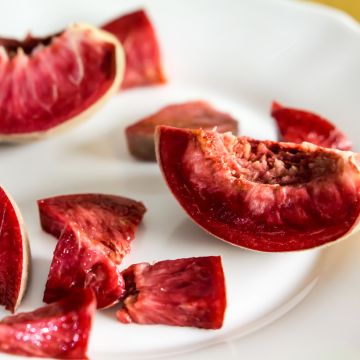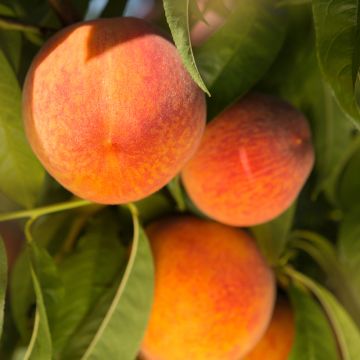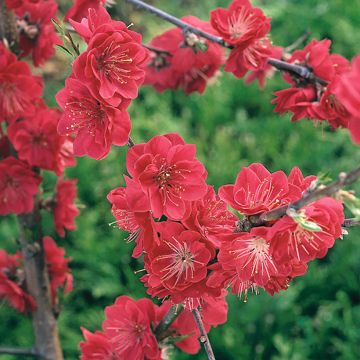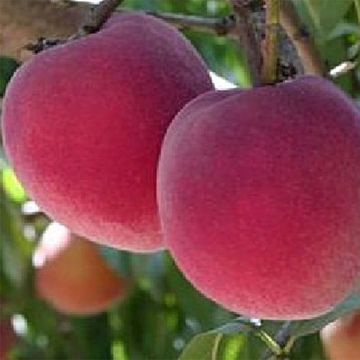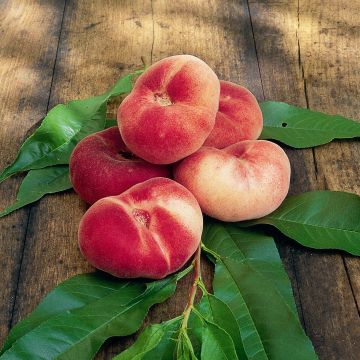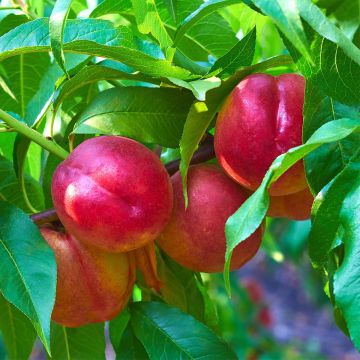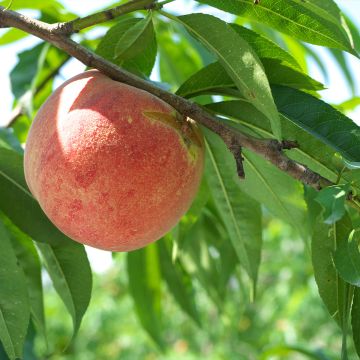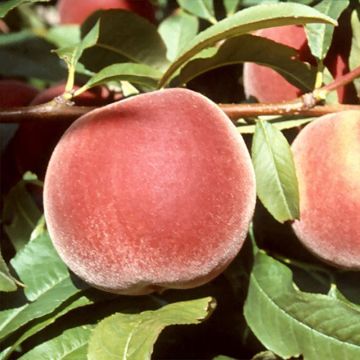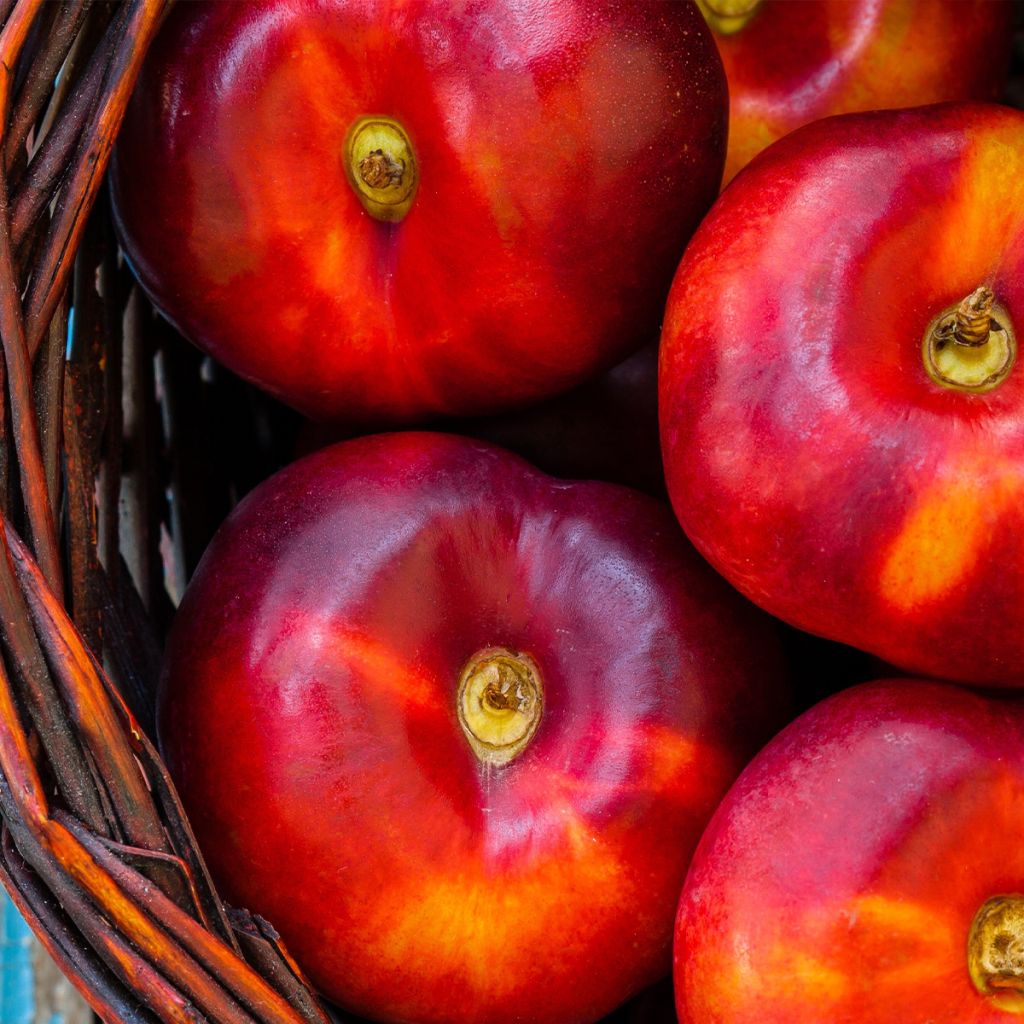

Prunus Flateryna - Flat-fruited nectarine tree
Prunus Flateryna - Flat-fruited nectarine tree
Prunus persica-nucipersica Flateryna
Nectarine 'Flateryna'
This item cannot be shipped to the selected country
Oversize package delivery charge from €6.90
Delivery to Corse prohibited
More information
Schedule delivery date,
and select date in basket
This plant carries a 6 months recovery warranty
More information
We guarantee the quality of our plants for a full growing cycle, and will replace at our expense any plant that fails to recover under normal climatic and planting conditions.
Oversize package: home delivery by special carrier from €6.90 per order..
Express home delivery from €8.90.
Delivery to Corse prohibited: UE law prohibits the import of this plant from mainland France to Corse as part of the fight against Xylella fastidiosa. Please accept our sincere apologies.
More information
Description
Prunus persica var. nucipersica 'Flateryna' produces flat nectarines in late summer. This fairly vigorous but small tree produces a beautiful light pink spring flowering. It is self-fertile, so it does not require another tree nearby to bear fruit. It produces small flattened red fruits that ripen in August-September. Their yellow flesh is juicy and sweet when consumed at harvest, and they can also be used in desserts. It is susceptible to leaf curl and requires regular treatments from late winter. Plant it in a sunny spot, in loose, fertile soil that retains some moisture in summer.
It is a member of the large Rosaceae family, which includes most of our fruit trees (apple, pear, cherry, plum). The species name "persica" was given to the peach tree because it was thought to originate from Persia. In reality, all cultivated forms of peach trees are native to northern China. It is the result of a natural mutation of the peach tree that occurred in the 16th century. It is a small deciduous and hardy tree that can be grown in all temperate regions, with a preference for the southern half. Its spring flowering, which is quite early, can be destroyed by late frosts.
'Flateryna' is a vigorous variety, but its mature size remains suitable for small gardens. It forms a small tree that reaches 3m (10ft) in height and 2m (7ft) in width. Trained as a half-standard, its short trunk carries numerous branches with vertical growth, giving it a slightly open, spreading habit. It starts bearing fruit at around 7 years old and has a lifespan of 15 to 20 years. Its foliage is a vibrant green and gives off a slight almond scent. It is deciduous and therefore sheds in autumn. Its leaves are long, measuring 8 to 15cm (3 to 6in) in length and 3 to 4cm (1 to 2in) in width, with a short petiole. Its light pink flowering occurs in April. The flowers are quite decorative but very sensitive to frost. Place the tree in a particularly sunny and sheltered location, such as in the corner of a stone wall. This tree is more commonly grown in Mediterranean-type regions, where it will be watered in summer. The flowers are hermaphrodite and self-fertile. They produce flat and irregular fruits that are initially yellow and red, before ripening to red. The fruits remain firm, thus extending the harvest over several weeks, from August to September. Nectarines that are picked slightly unripe will continue to ripen in the house.
Nectarines can be enjoyed raw or cooked, in sweet and savoury dishes. They can be flambéed, cooked in tarts, frozen, or deglazed. They pair very well with wine and duck. They can be found in many recipes, especially jams, compotes, and pastries.
'Flateryna' is ideal for small gardens where space is limited. You can plant it with dwarf fruit trees to create a compact orchard. There are many well-adapted modern varieties, such as the 'Garden Sun Red' apple tree, which can even be grown in a container and will delight you with its large sweet red fruits. The 'Belle Hélène' dwarf pear tree, whose fruits are as large as traditional varieties, is also a very good choice. As for cherry trees, the 'Garden Bing' cherry tree is a highly recommended self-fertile variety.
Report an error about the product description
Prunus Flateryna - Flat-fruited nectarine tree in pictures
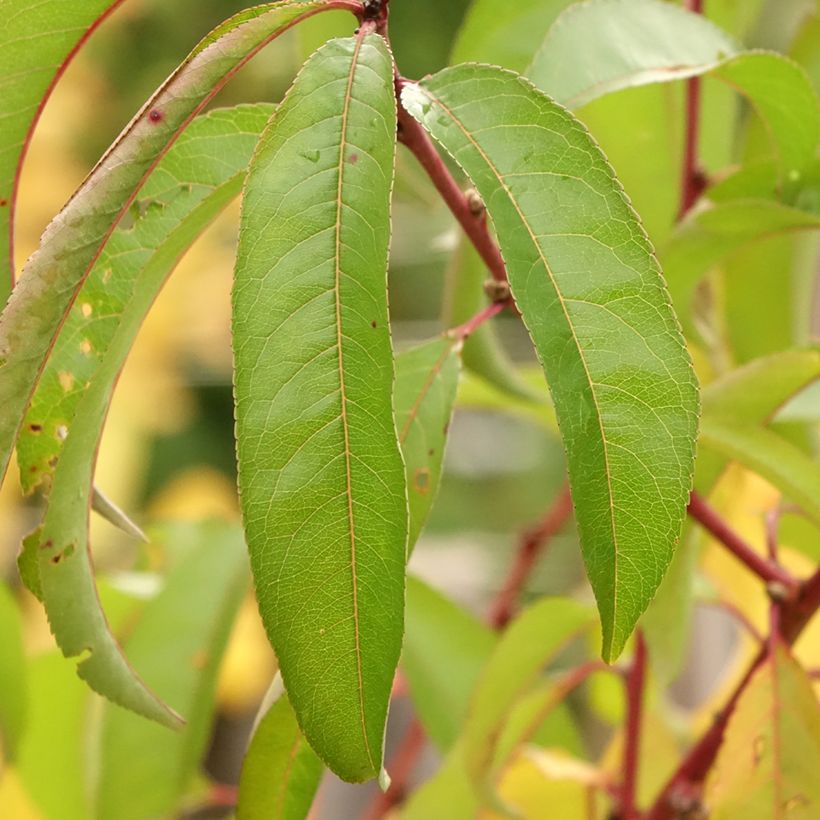

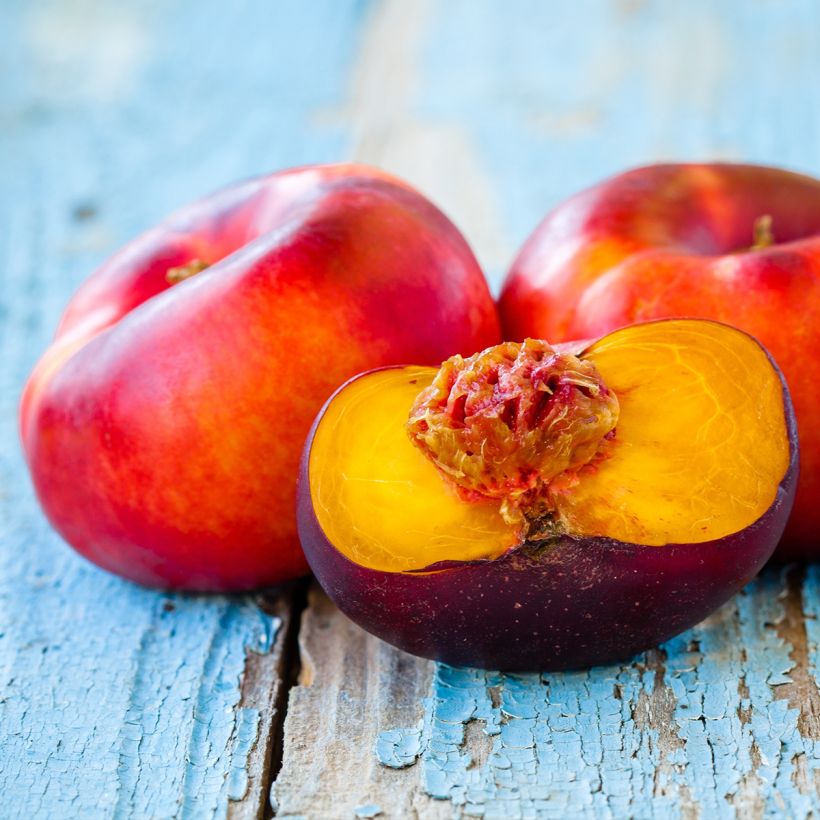

Plant habit
Fruit
Flowering
Foliage
Botanical data
Prunus
persica-nucipersica
Flateryna
Rosaceae
Nectarine 'Flateryna'
Cultivar or hybrid
Other Peach and Nectarine trees
Planting and care
Ideally, plant from September to November, in full sun, in a warm spot, sheltered from strong winds. Dig a hole two to three times wider and deeper than the pot. Place the tree with its pot in a basin of water for fifteen minutes to moisten the entire root ball by capillarity. Place compost at the bottom of the hole. Place the tree in the hole, fill with a mixture of soil and potting soil. Gently tamp around the base of the fruit tree as you fill, making sure the roots are in close contact with the soil. The root ball should be completely covered, but its surface should be level with the ground. Water abundantly to eliminate any air pockets around the roots. Plant a stake to secure your half-standard while allowing some movement to avoid damaging the bark and allowing the trunk to sway in the wind. This forces the plant to develop roots to anchor itself in the soil. You can remove the stake after 2 to 3 years of planting.
It has a semi-pivot root system. It will thrive in deep, loose, fertile soils that are light and well-drained.
Planting period
Intended location
Care
This item has not been reviewed yet - be the first to leave a review about it.
Haven't found what you were looking for?
Hardiness is the lowest winter temperature a plant can endure without suffering serious damage or even dying. However, hardiness is affected by location (a sheltered area, such as a patio), protection (winter cover) and soil type (hardiness is improved by well-drained soil).

Photo Sharing Terms & Conditions
In order to encourage gardeners to interact and share their experiences, Promesse de fleurs offers various media enabling content to be uploaded onto its Site - in particular via the ‘Photo sharing’ module.
The User agrees to refrain from:
- Posting any content that is illegal, prejudicial, insulting, racist, inciteful to hatred, revisionist, contrary to public decency, that infringes on privacy or on the privacy rights of third parties, in particular the publicity rights of persons and goods, intellectual property rights, or the right to privacy.
- Submitting content on behalf of a third party;
- Impersonate the identity of a third party and/or publish any personal information about a third party;
In general, the User undertakes to refrain from any unethical behaviour.
All Content (in particular text, comments, files, images, photos, videos, creative works, etc.), which may be subject to property or intellectual property rights, image or other private rights, shall remain the property of the User, subject to the limited rights granted by the terms of the licence granted by Promesse de fleurs as stated below. Users are at liberty to publish or not to publish such Content on the Site, notably via the ‘Photo Sharing’ facility, and accept that this Content shall be made public and freely accessible, notably on the Internet.
Users further acknowledge, undertake to have ,and guarantee that they hold all necessary rights and permissions to publish such material on the Site, in particular with regard to the legislation in force pertaining to any privacy, property, intellectual property, image, or contractual rights, or rights of any other nature. By publishing such Content on the Site, Users acknowledge accepting full liability as publishers of the Content within the meaning of the law, and grant Promesse de fleurs, free of charge, an inclusive, worldwide licence for the said Content for the entire duration of its publication, including all reproduction, representation, up/downloading, displaying, performing, transmission, and storage rights.
Users also grant permission for their name to be linked to the Content and accept that this link may not always be made available.
By engaging in posting material, Users consent to their Content becoming automatically accessible on the Internet, in particular on other sites and/or blogs and/or web pages of the Promesse de fleurs site, including in particular social pages and the Promesse de fleurs catalogue.
Users may secure the removal of entrusted content free of charge by issuing a simple request via our contact form.
The flowering period indicated on our website applies to countries and regions located in USDA zone 8 (France, the United Kingdom, Ireland, the Netherlands, etc.)
It will vary according to where you live:
- In zones 9 to 10 (Italy, Spain, Greece, etc.), flowering will occur about 2 to 4 weeks earlier.
- In zones 6 to 7 (Germany, Poland, Slovenia, and lower mountainous regions), flowering will be delayed by 2 to 3 weeks.
- In zone 5 (Central Europe, Scandinavia), blooming will be delayed by 3 to 5 weeks.
In temperate climates, pruning of spring-flowering shrubs (forsythia, spireas, etc.) should be done just after flowering.
Pruning of summer-flowering shrubs (Indian Lilac, Perovskia, etc.) can be done in winter or spring.
In cold regions as well as with frost-sensitive plants, avoid pruning too early when severe frosts may still occur.
The planting period indicated on our website applies to countries and regions located in USDA zone 8 (France, United Kingdom, Ireland, Netherlands).
It will vary according to where you live:
- In Mediterranean zones (Marseille, Madrid, Milan, etc.), autumn and winter are the best planting periods.
- In continental zones (Strasbourg, Munich, Vienna, etc.), delay planting by 2 to 3 weeks in spring and bring it forward by 2 to 4 weeks in autumn.
- In mountainous regions (the Alps, Pyrenees, Carpathians, etc.), it is best to plant in late spring (May-June) or late summer (August-September).
The harvesting period indicated on our website applies to countries and regions in USDA zone 8 (France, England, Ireland, the Netherlands).
In colder areas (Scandinavia, Poland, Austria...) fruit and vegetable harvests are likely to be delayed by 3-4 weeks.
In warmer areas (Italy, Spain, Greece, etc.), harvesting will probably take place earlier, depending on weather conditions.
The sowing periods indicated on our website apply to countries and regions within USDA Zone 8 (France, UK, Ireland, Netherlands).
In colder areas (Scandinavia, Poland, Austria...), delay any outdoor sowing by 3-4 weeks, or sow under glass.
In warmer climes (Italy, Spain, Greece, etc.), bring outdoor sowing forward by a few weeks.


































